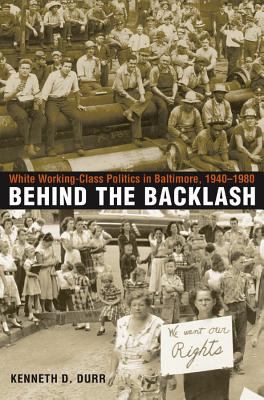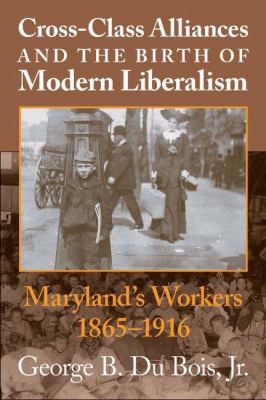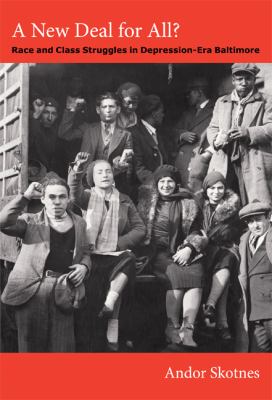by Lisa Greenhouse
For several decades now, the Democratic Party has been slowly hemorrhaging one of its traditional constituencies. In the late 1960s, Richard Nixon targeted some of these voters as part of his “Silent Majority.” In the 1980s, they were called Reagan Democrats. In 2016, the trend continued as many white working-class voters turned out for President Trump.

by Kenneth Durr
Book
There have been several theories as to why this has happened. Many scholars, journalists, and political observers attribute it to racial resentments. One book from the Maryland Department Collection, Kenneth D. Durr’s, Behind the Backlash: White Working-Class Politics in Baltimore, 1940-1980 (University of North Carolina Press, 2003), looks at this phenomenon on a local level in Baltimore and attributes it not to racism per se but rather to frustration with what the white laboring class saw as the liberal establishment’s lack of concern for its interests.
Durr recounts the formation of Baltimore’s New Deal Coalition when white liberals, black activists, CIO labor organizers, and white and black working people found common cause under Roosevelt’s banner. As long as the issues at hand were bread and butter, the coalition held. As civil rights and especially desegregation came to the forefront in the Postwar Period, the white working-class began its long, slow abandonment of the coalition, which is still ongoing at the end of the second decade of the 21st Century.
Durr suggests that working-class Baltimore’s populism, while initially focused during the Great Depression and WWII on challenging the capitalist class, eventually came to focus on opposition to perceived elites in government. The anti-Communism of the McCarthy era, which Baltimore’s workers embraced, served as a way-station along this path.
Blue collar Baltimore, as described in Durr’s book, was comprised of white ethnics as well as the Southern and Appalachian migrants who arrived in large numbers during WWII to take jobs in the steel and shipbuilding industries. Durr paints a picture of a white-working class in Baltimore that valued self-sufficiency and volunteerism. Identity was not so much tied up in work life as in the churches and clubs that were a part of community life. Their sense of responsibility, while highly developed in the neighborhood context, didn’t extend much beyond it.
Blue collar Baltimoreans recognized that the New Deal and the unionization efforts that the New Deal supported had raised their standard of living. Much of the increase in leisure time and income they experienced was invested in their communities. Yet they were ambivalent about union leadership and government bureaucrats, and they distrusted public sector unions. According to Durr, the 1950s were a prosperous time for Baltimore’s working class but external pressures were beginning to be felt. The exodus to the suburbs only increased the sense of protectiveness blue collars felt toward their neighborhoods.
According to Durr, in the 1960s, as Baltimore’s white working-class began to experience pressures for racial integration supported by Baltimore’s liberal establishment, they expressed their antagonism through “race talk.” Blue collar Baltimore was highly supportive of racist George Wallace’s 1964 Democratic primary run and George Mahoney’s 1966 race for Governor on an anti-open housing platform. Mahoney’s campaign slogan was “Your home is your castle; protect it.” Yet, in the author’s view, just as the national media began around 1970 to cover what it referred to as a backlash among the white working class to civil rights gains, blue collar Baltimoreans had already moved beyond focusing their anger at Blacks. They had begun to see liberal assaults on working people as the crux of the problem.
Durr’s book sometimes draws too fine of a distinction between racism and anger at liberals. After all, much of blue collar Baltimore’s problem with liberals — such as the ire directed at Baltimore Mayor Thomas D’Alesandro III — had to do with liberal support for racial integration. However, it is true that not all the issues that the working class had with liberals and experts in government were racial. The Supreme Court’s 1963 School Prayer decision (based in part on a suit brought by the Baltimore atheist, Madeline Murray O’Hare) seemed particularly egregious as did the various proposals that city planners came up with to run highways through city neighborhoods. The latter issue even united black neighborhoods and white working-class neighborhoods against government bureaucrats.
Durr sees blue collar Baltimore’s abandonment of “race talk” in favor of a language emphasizing law and order and responsibility as being more effective as well as a truer picture of laboring class concerns. Durr takes the law and order language at its face rather than seeing it as coded racism. The fondness of Baltimore’s largely Democratic urban working-class for the suburban (Baltimore County) Republican, Spiro Agnew, captured this movement away from explicit racism to a more generalized disdain for the liberal establishment and the forces of disorder that it seemed to be in league with. In today’s lingo, Agnew was “owning the libs” when he referred to liberal intellectuals as “an effete corps of impudent snobs.”
Whether or not we buy Durr’s nuanced argument that racism was not the prime driver of working-class alienation from the Democratic Party, the historical detail in Behind the Backlash makes it worth the read. We learn about conflicts between union leadership and rank and file union members and fissures in the local Catholic Church around issues of racial integration. We also learn about Baltimore figures like Charles Luthardt and his Fighting American Nationalists, a type that, unfortunately, never seems to have truly departed the American scene. Behind the Backlash delves deeply into battles we are still fighting and makes for a fascinating read.

by George Bache, Du Bois Book

by Andor Skotnes
Book
Readers interested in working-class Baltimore will find other books to interest them on the Maryland Department shelves. George Bach Du Bois’s Cross-Class Alliances and the Birth of Modern Liberalism: Maryland Workers, 1865-1916 (Chesapeake Books, 2009) treats the Post-Civil War era through the Progressive Era when parts of the later New Deal coalition were coming into focus. Andor Skotnes’s A New Deal for All: Race and Class Struggles in Depression Era Baltimore (Duke University Press, 2013) is an intricate look at two parts of the New Deal alliance in Baltimore: civil rights activism and labor activism. Both nicely compliment Behind the Backlash.